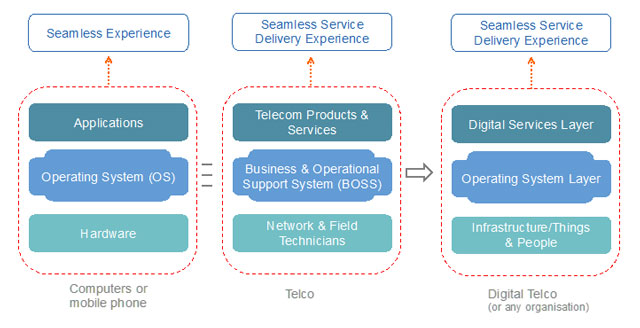 Telecommunications operators that have chosen to be more than utility providers of connectivity alone are fighting a battle to remain strategically relevant.
Telecommunications operators that have chosen to be more than utility providers of connectivity alone are fighting a battle to remain strategically relevant.
The story goes that digital disruption has rendered them, their technology and their systems to the role of mere logistics providers.
Telcos are seen to provide little more than dumb pipes, with the new kids of the block – over-the-top player digital peddlers — taking the moral and financial high ground.
But this perspective fundamentally misses the fact that telcos are uniquely positioned to embrace the digital world and already have the skills, experience and technology they need to do so. It’s all sitting in the back-office systems.
Most conversations about a telco’s competitive advantage revolve around the strengths of network technology and coverage, access to spectrum, existing customer base and established channels to market. But this overlooks the critical systems that integrate everything and makes it possible for the competitive advantage to be exploited — the backend — traditionally called business and operational support systems (BSS/OSS or simply Boss).
It is the telco’s Boss that knows all about the customer base, the products and services, the network’s state to fulfil these services and the whereabouts of field technicians. The Boss enables the connection of customers to services and then ensures that billing of usage occurs.
This operating system is the telco’s unseen nervous system and, without it, the network, spectrum, channels and the customer base could not all be integrated together into a functional whole.
The best way to understand the importance of a telco’s Boss is to see it as the operating system. It has deep parallels with a computer or mobile phone operating system, which manages software and hardware resources. In the telco world, the networks and field technicians are the hardware and software resources.
Moving into the digital future, the ability to understand and evolve the Boss into an operating system paradigm will make the difference between a telco becoming a “basic infrastructure utility” providing transport of data packets only (like a railway company) or a “sophisticated digital utility” — a digital telco in the digital services ecosystem.
The parallels between a conventional operating system and a telco Boss can also help to understand why the Boss and its role as the telco’s operating system is often left out of the strategic conversation.
The Boss operates in the background in the same subliminal way a computer’s operating system does, and the overall contribution to customer experience of service delivery is underestimated.
What customers really do care about is the frustration they experience when a call centre agent does not have relevant information at their fingertips, or when their broadband service goes down and nobody at the telco knows how to start fixing it. Or even worse, when a technician does not arrive at an agreed time. This experience is mediated by the telco OS — the Boss.
The digital services layer of a telco is also starting to make a larger contribution to overall service delivery experience in the form of self-help portals, free Wi-Fi connectivity and improved product and service showcasing.
But this is only the start, because monetising applications in the service layer is where the financial future lies. And with demand for applications such as voice and SMS in decline, without innovation around services telcos can only be low-margin pipe providers.
Darwinian logic
The TM Forum, a telco industry body which has for many years facilitated a collaborative community of operators and vendors in standardising the Boss, is now turning its vision to the digital ecosystem.
The forum argues that “at a minimum, Boss strategy must be a central part of the digital services strategy”. Any telco without a digital services strategy is one that has consciously chosen to be a utility provider of connectivity and transport of data only — in the new world, all traffic (including voice) is data and all products are digital services or smart devices (things).
Evolving to become a digital telco requires a change in viewpoint and changing the way that the Boss heritage is seen. The Boss is not just a back-end system only applicable to connectivity telco operations — it provides the momentum and trajectory into the world of digital services beyond connectivity alone.
A key part of the new viewpoint is a change in language and thinking where the Boss is a core element of an operating system-centric paradigm.
The operating system central layer provides an enabling platform by performing the function of a bridge between the digital world and the real physical world out there — integrating the two worlds into a cohesive whole.
It is the operating system layer, which will increasingly become the core capability of a telco whose intent is to evolve into a sophisticated digital utility.
It must be remembered that telcos are masters of many things, which are very important in the digital world.

They have been managing “things” since the first telephone running over copper cables was installed. These “things” have become increasingly intelligent over the years, with end points now being routers, broadband modems, and smart mobile phones. Now we have the “Internet of things” (IoT).
They have also been managing the telco switching core for a long time. This has evolved from manual to electromechanical to electronic circuit switching to mobile to Internet protocol switching and now the newly emerging concept of virtualised switching and software-defined networks. Many telcos have also entered the traditional cloud service provider business. Now we have the cloud platform for the IoT.
They have also been accurately billing millions of micro-transactions, such as voice calls, for decades, and in this sense they have digitised commerce since the first electronic telephone switch was installed decades ago. Now we have digital commerce.
Telcos have also been managing large-scale distributed fleets of field technicians too. The problem of getting a technician to the right place at the right time, when a customer is expecting them, is not an easy one. Now we have the “uberfication” of everything.
Last but not least, they have been working with large-scale, highly integrated software systems — the Boss that manages and orchestrates all of what I have just described. All the learnings of how to run such an operation are held in data structures, processes, business rules and the overall architecture of the operating system. Sometimes, unfortunately, it’s even held in the lines of code. Now we have the TM Forum digital services reference architecture for end-to-end orchestration of services across the digital ecosystem.
All of the above is located within the telco operating system layer.
Every decade, telcos evolve and become more sophisticated with each new technology and service that gets integrated into their operations, co-existing with the others. And through this the telco learns and becomes increasingly sophisticated. They may move slowly, treading very carefully — sometimes frustratingly so — but they do move consistently and continually forward.
Those telcos that choose to play a role beyond pipes only, and who do recognise the central importance of their operating system layer for their futures, are strongly positioned to live in the world of the digital services ecosystem where innovation is the key to survival.
Uber alles
If we look at the example of Uber, the latest poster child of disruptive technology, it’s not difficult to see that the problem space being solved by Uber systems in enabling a seamless taxi service experience, is not that different to the problem space of a telco.
Each and every day when a new telco service is ordered or a trouble ticket is logged, a field technician must be sent to the right place at the right time, along with the right vehicle, equipment and skills.
If we were to get a look under the bonnet of Uber’s software systems, I’ll bet that behind the slick, well-designed digital service application layer we will find an operating system which closely mirrors that of a telco Boss.
They will have different names, and different languages for describing the components, but they will contain similar mechanisms and technology. And the intent will be the same — a seamless service delivery experience.
There is no reason why a telco could not have given birth to Uber. But of course, they did not. Telcos who have been around for a long time are certainly not considered competitive disruptors.
The TM Forum put it this way: a telco “has not been built to compete but rather to deliver ubiquity, consistency and quality. In a regulated environment, every customer gets the same service the same way and quality is universally high, regardless of cost.”
The telco DNA will not be changed overnight, but this does not mean that the innovation conversation needs to stop.
One approach is to segregate digital as South Korea Telecom has done by placing its digital commerce activities into a separate company, called SK Planet.
SK Planet continues to work closely with SK Telecom, its sole owner, for good reason: the SK Telecoms Boss — the operating system layer — contains huge amounts of valuable information and there are deep potential synergies.
Another common approach is for telcos to establish an open innovation model where they work with entrepreneurial companies in the digital ecosystem, typically by establishing telco accelerators.
In an extensive article on this topic, telco strategist Sadiq Malik states: “A holistic innovation programme that can leverage accelerator programmes can also be taken, from opening application programming interfaces to key platforms and revisiting employee incentives, to realigning in-house capabilities with local market needs and opportunities.
“Nurturing and acquiring start-up capability is more than a ‘nice to have’ for many players; it is a mission-critical route toward new capabilities in an age where fresh approaches to service creation have never been more valued and improvements in time-to-market are vital.”
This kind of thinking was echoed at a 2014 South African CIO Council presentation where Gartner presented the idea of two-speed IT — with traditional IT working in parallel with small innovative players — especially when “speed or innovation is needed, or there is a high degree of uncertainty”.
Ecosystems, elephants and fleas
Influencers in the new digital era have borrowed ideas from science and the natural world, and we now speak about digital ecosystems, and symbiotic business relationships.
In the management philosopher Charles Handy’s book, The Elephant and the Fleas — Looking Back Into the Future, he writes about the future of work, and speaks of large organisations being elephants, and smaller agile, innovative businesses being “fleas” and living in symbiosis together.
Today, the old elephant telcos are joined by new elephants, their digital services counterparts — Google, Facebook and Amazon to name a few.
If telcos want to be more than pipe providers, the first step is to adopt a different viewpoint and recognize their Boss heritage as an asset that can be evolved into an operating system layer for the digital future.
And rather than becoming confused and upset by the pain caused by the new elephants and a myriad over-the-top disruptive digital players, telcos must put their operating system layer to play in new areas — and at the same time consider the symbiotic benefits of working with smaller agile fleas as partners in the digital ecosystem.
- Mark Acton is founder and MD of Cape Town-based Mobinomics

